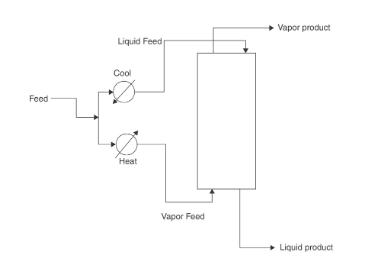At the end of Example 5-2, we noted that process simulators provide an easy method to do
Question:
At the end of Example 5-2, we noted that process simulators provide an easy method to do bubble- and dew-point calculations. One approach is to draw a flash distillation system with Flash 2 or a simple distillation column with RadFrac and make the feed the stream you want to analyze. For bubble point, set the feed as a saturated liquid, and for dew point, set the feed as a saturated vapor. The remaining specifications of the flash or the column can be assigned arbitrarily.
Example 5-2
At 1.0 atm, what are the temperature and vapor mole fractions in the reboiler (stage 0) if the bottoms product is 15.0 mol% isopentane, 30.0 mol% n-pentane, and 55.0 mol% n-hexane?
a. Find the bubble and dew points of a feed that is \(22.0 \mathrm{~mol} \%\) methanol, \(47.0 \mathrm{~mol} \%\) ethanol, \(18.0 \mathrm{~mol} \% \mathrm{n}\)-propanol, and 13.0 \(\mathrm{mol} \%\) n-butanol at 3.4 bar.
b. Find the bubble and dew points of the feeds in Problem 6.G7 at 3.4 bar.
Problem 6.G7
A column flash distillation (Figure 4-24) with three stages is processing a feed with \(10.0 \mathrm{~mol} \%\) methane, \(12.0 \mathrm{~mol} \%\) n-butane, \(33.0 \mathrm{~mol} \% \mathrm{n}\) pentane, \(25.0 \mathrm{~mol} \% \mathrm{n}\)-hexane, \(15.0 \mathrm{~mol} \% \mathrm{n}\)-heptane, and \(5.0 \mathrm{~mol} \% \mathrm{n}-\) octane. Streams \(\mathrm{F}_{\mathrm{V}}\) and \(\mathrm{F}_{\mathrm{L}}\) are both \(80.0 \mathrm{kmol} / \mathrm{h}\). Both feeds and the column are at 10.0 bar. Stream \(\mathrm{F}_{\mathrm{V}}\) is a saturated vapor, and stream \(\mathrm{F}_{\mathrm{L}}\) is \(95 \%\) liquid and \(5 \%\) vapor. Find the feed and product temperatures, the product flow rates, and the mole fractions of the distillate and bottoms products. Note: In the block statement for RadFrac, set Condenser = none and Reboiler \(=\) none.
Figure 4-24

c. Explain why the results are so different.
To find the feed temperature, go to Report (in the Home menu bar of Aspen Plus), click on the arrow by All, scroll down and select
Step by Step Answer:

Separation Process Engineering Includes Mass Transfer Analysis
ISBN: 9780137468041
5th Edition
Authors: Phillip Wankat




